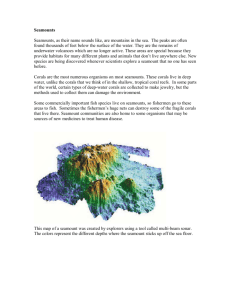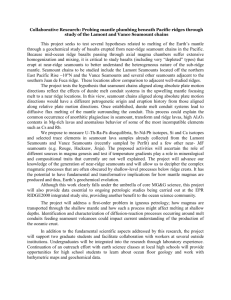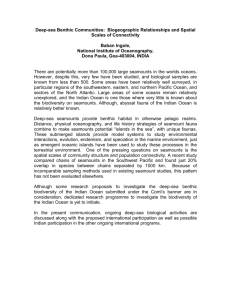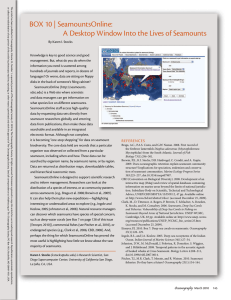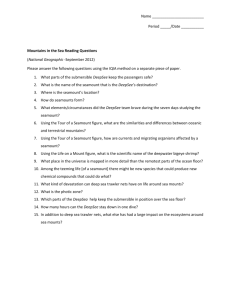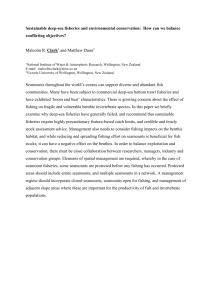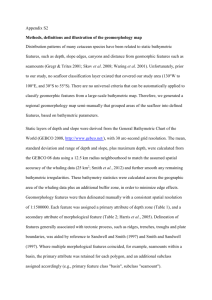Towards an international census of marine life research program on seamounts K.I. Stocks
advertisement
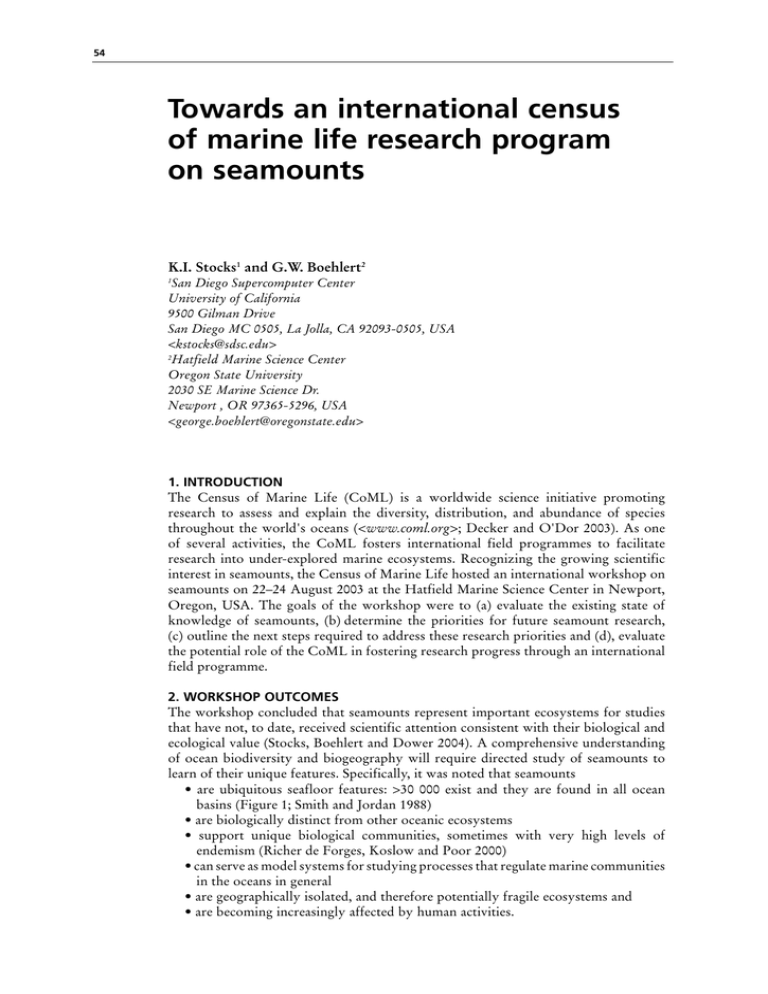
54 Towards an international census of marine life research program on seamounts K.I. Stocks1 and G.W. Boehlert2 San Diego Supercomputer Center University of California 9500 Gilman Drive San Diego MC 0505, La Jolla, CA 92093-0505, USA <kstocks@sdsc.edu> 2 Hatfield Marine Science Center Oregon State University 2030 SE Marine Science Dr. Newport , OR 97365-5296, USA <george.boehlert@oregonstate.edu> 1 1. INTRODUCTION The Census of Marine Life (CoML) is a worldwide science initiative promoting research to assess and explain the diversity, distribution, and abundance of species throughout the world's oceans (<www.coml.org>; Decker and O'Dor 2003). As one of several activities, the CoML fosters international field programmes to facilitate research into under-explored marine ecosystems. Recognizing the growing scientific interest in seamounts, the Census of Marine Life hosted an international workshop on seamounts on 22–24 August 2003 at the Hatfield Marine Science Center in Newport, Oregon, USA. The goals of the workshop were to (a) evaluate the existing state of knowledge of seamounts, (b) determine the priorities for future seamount research, (c) outline the next steps required to address these research priorities and (d), evaluate the potential role of the CoML in fostering research progress through an international field programme. 2. WORKSHOP OUTCOMES The workshop concluded that seamounts represent important ecosystems for studies that have not, to date, received scientific attention consistent with their biological and ecological value (Stocks, Boehlert and Dower 2004). A comprehensive understanding of ocean biodiversity and biogeography will require directed study of seamounts to learn of their unique features. Specifically, it was noted that seamounts • are ubiquitous seafloor features: >30 000 exist and they are found in all ocean basins (Figure 1; Smith and Jordan 1988) • are biologically distinct from other oceanic ecosystems • support unique biological communities, sometimes with very high levels of endemism (Richer de Forges, Koslow and Poor 2000) • can serve as model systems for studying processes that regulate marine communities in the oceans in general • are geographically isolated, and therefore potentially fragile ecosystems and • are becoming increasingly affected by human activities. Stocks & Boehlert 55 Important policy and management decisions regarding seamounts will be made in the next five to seven years (e.g. UN General Assembly considerations of marine protected areas) and good science will be essential for guiding management and conservation efforts. Further, the workshop participants determined that a CoML field programme on seamounts could have a valuable role in stimulating and coordinating seamount research. Workshop presentations on past and planned seamount work highlighted that seamounts are an area of active research. However, important science questions, detailed below, will not be addressed by simply continuing with a "business as usual" approach. In particular, there is a compelling need for an international effort to promote and coordinate future field efforts and synthesize existing knowledge in order to extend our results beyond individual seamount ecosystems. FIGURE 1 Seamount locations Squares indicate seamounts that have been sampled biologically (from SeamountsOnline; seamounts.sdsc.edu). Small black dots indicate predicted locations of ~14 000 seamounts (from Kitchingman and Lai 2004). 3. SCIENCE PRIORITIES To provide a scientific framework for the envisioned CoML program on seamounts, the following priority science question was articulated: "What roles do seamounts play in the biogeography, biodiversity, productivity, and evolution of marine organisms, and what is their effect on the global, oceanic ecosystem?". This primary theme was further sub-divided into three specific research themes. Theme 1 Given the large number of seamounts globally, can we categorize seamount community structures and, or, develop proxy variables in order to (a) use our knowledge from a limited number of well-known seamounts to make predictions about unknown ones, (b) efficiently guide future research programmes and (c), understand the key processes regulating the structure and maintenance of seamount communities? One topic considered was whether some minimal set of physical factors might be formulated in order to provide a biologically meaningful description and categorization scheme for seamounts. Although by no means exhaustive, the following list of factors were identified as being important to consider in any such scheme: 56 International census of marine life • physical and geological setting of the seamount (age, substrate type, etc.) • geography (latitude, ocean basin, distance from nearest continental margin, etc.) • seamount size, depth, shape and physiography and • productivity of the overlying water column and its associated hydrographic characteristics (e.g. localized upwelling, presence of recirculating eddies such as Taylor columns and relationships to mesoscale oceanographic features). Theme 2 How do seamount communities, both within and between seamounts, differ in ecological structure and function? This theme explicitly recognized that there can be substantial patchiness within a given seamount as well as between seamounts, and that variability at both scales is important for understanding seamount ecosystems. Particular questions of interest include: How do the physical characteristics of a given seamount influence the composition of communities that occupy its various habitats? What are the roles of biological interactions (e.g. trophic structure and food web function) both within seamount communities and with surrounding ocean communities? How vulnerable are seamount ecosystems to disturbance, and how might the structure of these ecosystems change in response to natural (e.g. seasonal variability, inter-annual cycles, climate change) and anthropogenic (e.g. overfishing) influences? What roles do larval dispersal and recruitment dynamics play in the long-term persistence of seamount populations? How do the surrounding deep-sea communities interact with seamounts? On what scales do seamounts influence the biological and physical structure of adjacent oceanic habitats (i.e. what is the spatial and ecological "footprint" of a seamount or seamount chain in the surrounding ocean)? Theme 3 On a broader scale, what roles do seamounts play in global oceanic ecosystems with respect to (a) biogeography, (b) biodiversity, (c) evolution and (d), productivity? This theme will involve the synthesis of seamount studies from around the world. Specifically, workshop participants proposed investigating issues such as whether seamounts act as centres of speciation or as refugia for relict populations, to what extent do seamounts serve as stepping-stones for trans-oceanic dispersal and whether they represent regional hotspots of biological production, which may be important e.g. for migratory species. 4. PROPOSED ACTIVITIES To address the priorities stated above, workshop participants identified several key planning and research activities. The primary focus will be on developing an international scientific programme that concurrently catalyzes and coordinates field sampling while continuing databasing and data analysis efforts. Activity 1: Promoting future field sampling Given that fewer than 150 of the tens of thousands of seamounts have been explored in any detail (Figure 1), new field research is obviously critical to improving our understanding of seamount biogeography. Therefore, supporting and coordinating existing field efforts and developing new collaborative projects have been identified as high priorities for a future CoML seamount program. While funding is always a limiting factor for expedition work, the growing concerns, both within many countries and internationally, over human impacts on seamounts may open new sources of funding. In addition to leveraging funds for new initiatives, future seamount research should also be linked to existing sampling programmes and, where appropriate, national agendas (e.g. several nations, including Australia, New Zealand and Canada, already have programmes underway to protect certain seamounts within their Exclusive Economic Zones). Stocks & Boehlert Workshop participants recommended that a planning stage for this activity address: • Standardized sampling. A minimum set of standardized samples and data should be defined that is required or recommended for all participating field programmes. • Scientific impacts. Seamounts are already known as potentially fragile habitats. The project may need to develop practices or recommendations to ensure that negative impacts from research activities (e.g. sample collection) are minimized and documented. • Sampling priorities. Based in part on the results from Activity 3 (below), it should be possible to rank a list of seamounts in terms of the importance for research attention. This could be based either on (a) a lack of existing seamount data from a particular part of the world ocean or a category of seamount or (b), the recognition that a particular seamount (or seamounts) is at imminent risk from fishing or other destructive activities. • Defining the programme scope. While geologists have a strict definition of seamounts (a feature over 1 000 m high and of restricted spatial extent) there is growing evidence that this definition is not biologically meaningful. Even relatively small hills and offshore banks can have many of the ecological features of “true” seamounts (e.g. Probert, McNight and Grove 1997, Koslow et al. 2001, Rowden, O’Shea and Clark 2002). If seamounts are defined too narrowly within this programme, there is little incentive for groups working in allied hill and bank systems to participate in the programme and provide valuable comparative data. • Taxonomy. Workshop participants highlighted that the lack of taxonomic expertise and the need for quality control and standardization of taxonomy will be challenges for a seamount field programme. It was noted that this is an issue that cuts across all CoML field programmes. Activity 2: Networking and coordination The scope of the science recommended above will require substantial coordination within the international scientific community. Geographically, it is desirable (indeed essential) that many countries participate, given how widely distributed seamounts are and how many lie in international waters. Scientifically, expertise from a wide range of fields (e.g. genetics, population biology, fisheries biology, physical oceanography, geology, taxonomy, ecosystem ecology, etc) will be needed. Further, a variety of existing programmes (e.g. MAR-ECO <mareco.imr.no/index.html>; OASIS <www.rrz.unihamburg.de/OASIS/>; NOAA Ocean Explorations <oceanexplorer.noaa.gov>) are undertaking seamount research. These programmes typically have objectives that are consistent with the science objectives identified by this workshop, and can provide established networks of experts. Facilitating collaboration among these projects, while not competing with them, will be critical. During the planning phase of a CoML seamount project, international planning workshops will bring together the varied scientific expertise required and help to engage scientists who were not represented at the initial CoML seamount workshop. By these means we will involve a broader group of scientists and expertise to improve the design of the scientific programme. Presentations at established scientific meetings will be used to raise awareness of the project. Activity 3: Databasing and retrospective analyses A substantial body of work exists on seamount biogeography and ecology (Figure 1). To date, however, these data remain fragmented and, in many cases, are all but inaccessible to the scientific community. Several information systems relevant to seamount biology were demonstrated at the workshop: SeamountsOnline <seamounts.sdsc.edu>, the Seamount Catalog of EarthRef <earthref.org> and the MBARI Video Annotation and 57 58 International census of marine life Reference System <www.mbari.org/vars/>. The workshop participants recommended that the planning phase for a global CoML seamount project must continue the development of an online seamounts database and help create an analysis and synthesis effort on existing data. This is not to say that future field studies should not be undertaken until such a synthesis is complete, but rather that full advantage must be taken of existing data to assist in the planning and refining of future field efforts. After the planning phase is complete, efforts to further develop databases should continue for the repository and archiving of new data collected during the field programme and as the programmes’ contribution to the Ocean Biogeographic Information System (Zhang and Grassle 2003, www.iobis.org). Activity 4: Outreach As photogenic and exciting habitats, seamounts have a rich potential for public outreach and for pre-collegiate education efforts. Because of the emerging interest in conservation issues of seamounts – such as national and international efforts to site marine protected areas on seamounts and manage seamount fisheries – communicating science results to managers and decision makers was highlighted as a special emphasis for a future CoML seamounts programme. While it is beyond the scope of the CoML to make policy recommendations, scientific outcomes from seamount research are likely to be critical to decision making. Because the traditional lines of communication between science and management (i.e. publication in the primary research literature) are often not effective, new mechanisms should be considered. 5. THE NEXT STEPS The next actions towards realizing a Census of Marine Life International Field Program on seamounts will be further outreach efforts to scientists not represented at the workshop, further refinement of the science plan and the development of a programme secretariat for coordination. Anyone interested in participating in this effort or learning more can contact the authors or visit seamounts.sdsc.edu and follow the links to the CoML Seamount Program. 6. ACKNOWLEDGEMENTS The authors would like to thank the Census of Marine Life and the Alfred P. Sloan Foundation for providing the funding necessary to hold this workshop. We also thank the workshop participants for their valuable contributions before, during, and after the workshop: Nancy Baron, Jacqui Burgess, Gregor Caillet, Bernd Christiansen, Sabine Christiansen, Judith Connor, Cynthia Decker, Heino Fock, Karen Garrison, Linda Glover, Raymond Highsmith, Baban Ingole, Eva Ramirez Llodra, Jon Moore, Bhavani E Narayanaswamy, Ron O'Dor, Alex Rogers, Evgeny Romanov, Ashley Rowden, Thomas Schlacher, Tim Shank, Ross Shotton, Igor Smirnov, Paul Tyler, Franz Uiblein, Mike Vecchione, Eric Vetter, Waldo Wakefield, Alan Williams, Mary Yoklavich. 7. LITERATURE CITED Decker, C.J. & R. O’Dor 2003. A Census of marine life: unknowable, or just unknown? Oceanologica Acta, 25: 179–186. Kitchingman, A. & S. Lai 2004. Inferences on potential seamount locations from midresolution bathymetric data. In T. Morato and D. Pauly (eds) Seamounts: Biodiversity and Fisheries. Fisheries Center Research Reports 12(5): 7-12. Koslow, J.A., K. Gowlett-Holmes, J.K. Lowry, G.C.B. Poore & A. Willams 2001. Seamount benthic macrofauna off southern Tasmania: community structure and impacts of trawling. Mar. Ecol. Progr. Ser. 213: 111–125. Stocks & Boehlert Parin, N.V., A.N. Mironov & K.N. Nesis 1997. Biology of the Nazca and Sala y Gomez Submarine Ridges, an Outpost of the Indo-West Pacific Fauna in the Eastern Pacific Ocean: Composition and Distribution of the Fauna, its Communities and History. Adv. Mar. Biol. 32: 145–242. Probert, P.K., D.G. McKnight & S.L. Grove 1997. Benthic invertebrate bycatch from a deep-water trawl fishery, Chatham Rise, New Zealand. Aquatic Conservation: Mar. Freshw. Ecosyst. 7: 27–40. Richer de Forges, B., J.A. Koslow & G.C.B. Poore 2000. Diversity and endemism of the benthic seamount macrofauna in the southwest Pacific. Nature 405: 944–947. Rowden, A.A., S. O’Shea & M.R. Clark 2002. Benthic biodiversity of seamounts on the northwest Chatham Rise. Marine Biodiversity Biosecurity Report No. 2. Wellington: New Zealand Ministry of Fisheries, 21pp. Smith, D.K. & T.H. Jordan 1988. Seamount statistics in the Pacific Ocean. J. Geophys. Res. 93: 2899–2919. Stocks, K.I., G.W. Boehlert & J.F. Dower 2004 in press. Towards and international field program on seamounts within the Census of Marine Life. Archive of Fisheries and Marine Research 51. Zhang, Y. & J.F. Grassle 2003. A portal for the Ocean Biogeographic Information System. Oceanologica Acta 25: 193–197. 59
